Tamela Rich's Blog, page 15
January 17, 2012
How Much will you Charge to Ghostwrite My Book?
[image error]Potential clients always want to know how long it will take to turn the content they're been collecting into a book and how much I will charge to ghostwrite it for them. "Can you at least give me a range?" they ask.
Not to answer like a two-handed economist, but it depends. Before I can accurately scope my work effort, which is how I determine my fee, I'll ask you some questions of my own.
Do you have a table of contents? This is not to say your outline will go unchanged, but the process of developing a table of contents (TOC) forces you to think critically about what you really want to convey and how. Yes, I can help you develop your TOC as part of the overall project or as a preliminary engagement, but if your budget is tight this is a good place to put your sweat equity.
How well organized is your source material? Not just your original content, but also industry resources that you want to quote or refute. Is the source material pegged to chapters in your TOC? As I said above, the process of compiling your materials will serve you well.
What is the single most important point of your book? If you can't state this in 200 words or less I can't begin writing. No worries, though, I can help. Rest assured, I won't let you slide with something that isn't crisp and cogent.
What are three skills or takeaways your reader will glean from the book? Maybe you have more than three, but you catch my drift.
What are your goals for the book? I want your book to meet your goals, too. Here's a post on the goals I had for Live Full Throttle: Life Lessons from Friends Who Faced Cancer.
Start with a "Goldilocks Chapter"
Once you've got the outline, source material and reader objectives, I'll be able to price writing a Goldilocks Chapter.
What's a Goldilocks Chapter? Remember the story of Goldilocks and the Three Bears? One chair was too big, another was too small and the third was just right; one bowl of porridge too hot, another was too cold and the third was just right. In similar fashion, a Goldilocks Chapter isn't the longest or shortest chapter in the book; it isn't the introduction or the summary. It's a chapter that represents both the the length and the level of difficulty of the average chapter in the book. The Goldilocks Chapter will give us a feel for our working relationship and give me a mini project from which to price the entire book.
It should take two or three weeks to finalize your Goldilocks Chapter. We need time to let the chapter cool down before the final round of edits so we can approach it with fresh eyes, so don't try to rush the process. I remember sitting down to read the final copy of a book I recently wrote, turning to my collaborator and saying "What in the world did I mean by that?" You don't catch errors like that when you write, edit and proof-read like a college kid turning in a term paper in the morning.
Average pricing for a Goldilocks Chapter
 Let's assume you have a strong sense of what you want to say, how you want to say it, and you've done your research. Count on spending $2500 to get your Goldilocks chapter ghostwritten and edited. At the end of the Goldilocks Chapter project we'll both know what's ahead of us to finish the book.
Let's assume you have a strong sense of what you want to say, how you want to say it, and you've done your research. Count on spending $2500 to get your Goldilocks chapter ghostwritten and edited. At the end of the Goldilocks Chapter project we'll both know what's ahead of us to finish the book.
This is the juncture at which you can take the chapter and include it in a book proposal or bring in another collaborator. I promise you, this is the best way I've found to start a project.
This does NOT mean that every chapter will cost $2500. They will not. There is a great deal of preliminary work in the Goldilocks Chapter that will help us both as we finish writing the book or book proposal. One is the process of transferring your voice to me. The book needs to sound like you–only better.
Once the Goldilocks Chapter is finished, the rest of the book will flow.
Average pricing for the rest of the book
I suggest budgeting $7500 for a 15k-word book, including edits, which I sub-contract (no one should edit their own work). I'll sub-contract a graphics expert for graphs, charts and other illustrations, too (I'm a wordsmith, not a designer).
If your book runs to 30k words budget $12k, but let's not get out ahead of ourselves with this budgeting business.
Let's write that Goldilocks Chapter first.

January 8, 2012
Resolved to Write a Book?
Within the last week of 2011 over four million Android devices were activated. What does this mean to the business professional who has been waiting to write a book? You'd better get with it.
Every day over 500k devices are activated that people could be using to read your message–or someone else's. Yes, even Apple users can read what you've written if you publish it on the Google eBookstore (which means there is no need to wrestle with publishing to the iBookstore).
Like snowflakes to an avalanche
If you've made resolution to write a book this year but haven't written so much as a blog post or newsletter, start with one of those projects. If you've been blogging or writing articles, white papers or newsletters for a couple of years, you've got a running start at a 15,000-word book. Here's how quickly your smaller projects could add up:
Do you read newspaper opinion columns? They average 700 words, so if you've written 22 pieces of that length, you could compile them into a book.
Most blog posts average 300+ words, so 50 posts would total 15,000 words. Count the average words in your blog posts and do the math.
How many speeches or presentations have you delivered? Those add up, too. If standard speech without long pauses runs 150 – 170 words per minute, a 20-minute speech is 3,000 to 3,400 words. If you've delivered five 20-minute speeches on your subject, you're ready to roll.
If you think you're ready to begin or want to talk about how to begin writing a book, contact me. Our first consultation is on the house.

December 27, 2011
Book Tour: SoCal to Seattle
After a great book debut at Dilworth Billiards in North Carolina 12/8, I jumped on a flight the next morning for the West Coast to promote "Live Full Throttle" in cities where the International Motorcycle Show is touring.
Long Beach
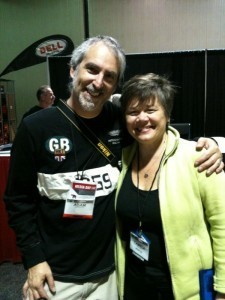
Southern California was my first stop, and the show in Long Beach is one of the largest on the tour because so many companies have a presence in SoCal.
In addition to signing books and finding distributors for it, I met social media friends for the first time in real life (including moto-journalist Adam Mercado, aka @LeanAngles) shown here.
I saw several marvelous bikes in the "Dream Pavilion"including the Moto Guzzi v7 Racer, which made me swoon a little. I love the looks of a classic bike and of course the Italians are wonderful designers. My friend Neale Bayly, a moto-journalist tells me it's a sweet ride too.
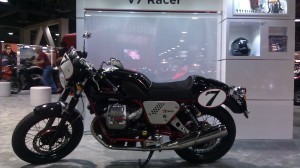
Friday night I signed books at Yellow Devil Gear Exchange just a mile from the show. Yellow Devil has a terrific concept–a motorcycle swap and consignment shop with some brand new merchandise sprinkled in for good measure. You can find everything from helmets to racing suits and vintage "motorabelia" like posters and key chains.
San Francisco
After a quick flight up the coast Sunday night, I spent Monday with photographer Christina Shook, who collaborated with me on Live Full Throttle. We brainstormed book marketing while getting pedicures in Orinda (eat your heart out corporate marketing drones in your gopher cubes!). Later that night, over bowls of chili with friends, I rehearsed my book tour presentation. Thanks to their feedback and suggestions, the reception it got in Portland and Seattle at the end of the week was unanimously positive.
Motorcycle Gear Shopping
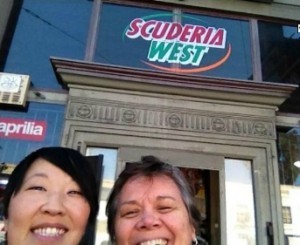
In an effort to improve my "big city" commuter skills I took BART (the train) from Christina's to San Francisco's Mission District, where I ate breakfast at the terribly-named but deliciously-stocked Pork Store with my friend Joanne Donn (aka @GearChic). Fortunately I didn't have to make any transfers in my commutes. A lesson for another day.
Joanne then helped me find new Rev'It motorcycle pants at Scuderia West, also in the Mission District. What a treat, having a personal shopper! She knew which brands offer the functionality I need in cuts for my "American" proportions and emphasized the importance of proper fit. It hadn't really occurred to me how dangerous my now-baggy gear had become (I've lost weight since I bought the gear in 2010), but skid pads slide away from the areas you want to protect when baggy gear meets the pavement. Ouch.
Marin County Cancer Institute
The next day was spent with friends across the bay in Novato, who took me to the Marin County Cancer Insitute, where one of them is being treated for breast cancer. I learned that Marin County is a breast cancer "hot spot," which means the incidence of breast cancer per capita is extremely high.
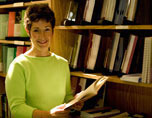 After touring the Institute, I met Cancer Resource Specialist Diane Brandon (pictured right), who enthusiastically placed a copy of "Live Full Throttle" in the resource center and introduced me to the gift shop team, recommending the book for sale there. I fully expect to see the book in the gift shop soon!
After touring the Institute, I met Cancer Resource Specialist Diane Brandon (pictured right), who enthusiastically placed a copy of "Live Full Throttle" in the resource center and introduced me to the gift shop team, recommending the book for sale there. I fully expect to see the book in the gift shop soon!
Portland
Another quick flight brought me to Portland, where I signed books at Latus Motors, a Harley-Davidson dealership. 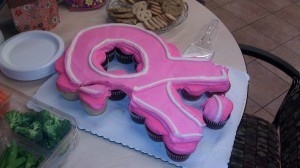 My dear friend Nadine, who put me up at her farm and arranged the signing with Latus, ordered cupcakes with pink frosting ribbons from Safeway and we were both surprised when she picked up this cupcake cake instead. I've never seen so much frosting in my life!
My dear friend Nadine, who put me up at her farm and arranged the signing with Latus, ordered cupcakes with pink frosting ribbons from Safeway and we were both surprised when she picked up this cupcake cake instead. I've never seen so much frosting in my life!
Latus has a strong community of riders and in spite of rain and cold the week before Christmas, about 20 of them turned out to hear me talk about the Conga rides I've taken over the last two summers and the story behind "Live Full Throttle." As with Long Beach, many of them were social media friends that I was happy to hug in the flesh.
New Friends Facing Cancer
In the middle of my talk, one woman dashed in with fresh news that a neighbor had just that day been diagnosed with cancer and asked me to quickly sign a book so that she could take it to him.
As often happens, one woman bought two books, one for herself and another for her sister. She had breast cancer a few years ago and her sister has a recent diagnosis.
An oncology nurse, whose father has cancer, surprised herself by crying during my talk. She thanked me for putting her in touch with feelings that her profession has caused her to sometimes repress.
On an upbeat note, I also met a wish grantor for "Make A Wish" and learned about the training and screening processes she went through to make wishes come true for children with life-threatening illnesses.
I'm grateful for the people and stories that keep coming into and blessing my life. As I've said before, motorcycling brought me to the cancer community quite unexpectedly. I'm here for a reason that is not clear to me just yet, and trust that I can be a channel for good as I continue walking this path.
Seattle
 I love traveling by train, so I was delighted to learn that for $51 I could travel from Portland to Seattle on Amtrak's Cascades line. Here's a picture from the dining car.
I love traveling by train, so I was delighted to learn that for $51 I could travel from Portland to Seattle on Amtrak's Cascades line. Here's a picture from the dining car.
Continuing my big-city commuter education, I jumped on a city bus instead of renting a car or hiring a cab to get to the apartment I had rented in the Lakeside area of Seattle. I find mass transportation to be sooooo convenient (and cheap). I wish my city, Charlotte, had a more complete system. We have a meager bus service and a tiny line of light rail. That's it. I digress.
Speaking at the International Motorcycle Show
Saturday morning I opened the show with a talk on recommendations for newbie riders. After all, three months after I passed my licensing course last year I set off on a coast-to-coast journey, and repeated it this year, returning unschathed both times.
Since these trips involved fundraising with my Conga friends, I talked about traveling with a pink bra strapped across my bike's windshield and gave some of the back story of "Live Full Throttle." One of the women in the audience burst into tears when I told this story, then returned several minutes later to finish hearing what I had to say. Since she didn't approach me, I am unsure what provoked her tears, but I bet was related to cancer.
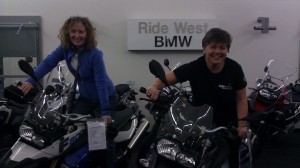
Later that day I signed books at Ride West, a top-drawer BMW Dealership in Seattle. My Conga sis, Karen, joined me there and we horsed around on the bikes and talked to riders about don't-miss routes in the NorthWest. Honestly, if you can't be ON your motorcycle, the next best thing is to be at a motorcycle shop mixing it up with fellow riders!
Touring Seattle
 Karen stayed with me through Monday, and as a Seattle native, took me to all the great spots in the city, including Pike Street Market. Note the two passing ferries in Elliott Bay, which I shot from Queen Anne's Hill.
Karen stayed with me through Monday, and as a Seattle native, took me to all the great spots in the city, including Pike Street Market. Note the two passing ferries in Elliott Bay, which I shot from Queen Anne's Hill.
Seattle is a vibrant city and I have a little list of things to do next time I return, but I couldn't live anywhere with so little direct sunlight. I had formed the idea that it rains a lot there, but was mistaken. However, the topography snags clouds, which both blocks sunlight and traps moisture. Karen tells me that the locals call it a "sunbreak" when the sun breaks through the clouds. No wonder they like strong coffee.
Seattle Cancer Care Alliance
 Monday we toured the Seattle Cancer Care Alliance (SCCA), where Karen is a patient (and whose doctor LOVES "Live Full Throttle").
Monday we toured the Seattle Cancer Care Alliance (SCCA), where Karen is a patient (and whose doctor LOVES "Live Full Throttle").
The SCCA's patient areas are situated with lovely views of Elliott Bay through floor-to-ceiling windows. Eclectic art adorns the walls and corridors. I particularly enjoyed stepping into the little sanctuary, where visitors can sit on meditation cushions or chairs as they contemplate books and mementos from the world's religions. Here's a snapshot of the focal point. Note the kid-sized table and chairs below the adult-sized versions. After all, cancer affects people of all ages.
SCCA is a beautiful place and serves the only hospital food that I've ever truly enjoyed. Why do hospitals serve gray, greasy, over-processed and otherwise unhealth food, anyway? Another digression.
After speaking with the managers of the book and gift stores at SCCA, it looks like I'll be back in Seattle in March for a book signing event. I may try to combine it with a visit to the EuroMoto show in nearby Lynnwood.
So this is how I combine motorcycling, writing, and humanitarianism. I am a truly fortunate woman.
Please tell me if you would like to host a speaking and signing event or if you know someone else who would. The rest of the IMS tour cities are listed here but I'm not limited to signing only in those cities.


December 9, 2011
West Coast Book Tour Schedule, December 2011
Thanks to everyone who came out to Live Full Throttle's debut at Dilworth Billiards. Great pictures here by my friend Terry Pittman.
"Live Full Throttle by Tamela Rich 12/07/2011 (Photos by Terry Pittman)"
Create a free slideshow with Picnik!
The next morning I jumped on a plane for my West Coast tour. Please find me and introduce yourself!
Friday, December 9, Yellow Devil Gear Exchange signing books from 6-8
Saturday and Sunday, December 10-11 International Motorcycle Show (IMS), Long Beach with the WRAPTER booth
Thursday, December 15, Latus Motors 4:00-6:00 pm (870 E. Berkeley St., Gladson, OR) (Portland area)
Saturday, December 17, IMS Seattle 10:30 am (Convention Center)
Saturday, December 17 at Ride West BMW 2:00-4:00pm (8100 Lake City Way NE, Seattle, WA)


December 4, 2011
Live Full Throttle Book Debut!
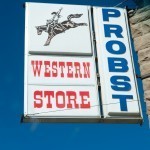
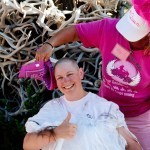
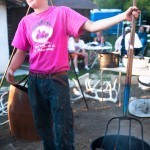
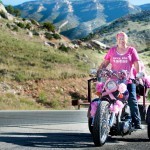
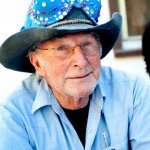
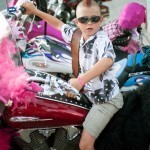
Please join me as I launch Live Full Throttle: Life Lessons From Friends Who Faced Cancer.
When: Wednesday, December 7, 2011 from 5-7pm
Where: 300 East Tremont Ave Charlotte, NC 28203 Dilworth Billiards
After riding my motorcycle through 25+ states with a pink bra strapped across the windshield for breast cancer causes, I've collected a lot of wit and wisdom about life from friends who faced cancer.
Drop by Dilworth Billiards any time from 5-7 to hear some of my friends' stories. I'll run slides from this year's roadtrip on the wall and bring plenty of copies of the book.
Napoliltano's will be there with Italian fare like paninis, pasta fagioli, minestrone and tuscan white bean soups, and chocolate ravioli for dessert.
If the weather permits, hang out around the koi pond in the courtyard or stay indoors and pick up a cue stick. Dilworth Billiards has been a great supporter, having hosted Think-Drink-Eat-Pink before I left for this year's roadtrip.
I'd love to see you, whether you buy a book or just come to wish me well. Nothing formal; leave your tiara at home but bring a friend or co-worker.


November 22, 2011
Mark Cuban Did It and So Should You
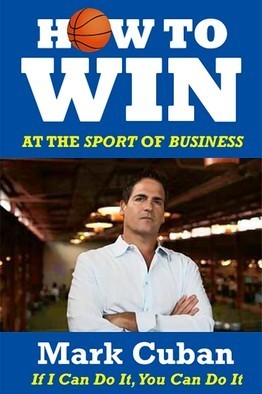 For a couple of years now I've been telling you to harvest your blog posts, white papers and newsletters into a book. Could it be that Mark Cuban has been listening all along?
For a couple of years now I've been telling you to harvest your blog posts, white papers and newsletters into a book. Could it be that Mark Cuban has been listening all along?
Until he says otherwise, I'm taking credit.
Cuban's book, "How to Win at the Sport of Business: If I Can Do It, You Can Do It" is admittedly harvested from years of blog posts and sells for $2.99.
Here's a guy whose blog readership hits between 50k-1m readers and he's trying to sell what's already out there in an ebook? Yep, and So Should You!
The WSJ notes that Cuban "refocused" the work and doesn't expect readers to take it in like a literary masterpiece. "Don't feel you have to read it like a book," he writes in the book's foreword. "Use it as a way to get fired up. A way to get motivated."
Cuban's book is about 30k words but I say you can go to market with half that.
Here's how to start writing a book:
Do you read newspaper opinion columns? They average 700 words, so if you've written 22 pieces of that length, you could compile them into a book.
Most blog posts average 300+ words, so 50 posts would total 15,000 words. Count the average words in your blog posts and do the math.
How many speeches or presentations have you delivered? Those add up, too. If standard speech without long pauses runs 150 – 170 words per minute, a 20-minute speech is 3,000 to 3,400 words. If you've delivered five 20-minute speeches on your subject, you're ready to roll.
Your old newsletter articles are good book fodder.
Read my series on writing, designing, publishing and promoting my book. Better yet, let's get started on YOUR book.


November 18, 2011
Distribution: Self-Publishing's Final Hurdle
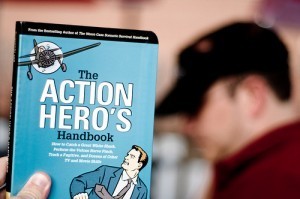 The last step in the self-publishing process is getting the book into the reader's hands (or reading device). I'm not talking about marketing in this post (I'll talk about that later); I'm talking about dead-tree distribution here because that's how I published Live Full Throttle, for reasons I outlined earlier in this series.
The last step in the self-publishing process is getting the book into the reader's hands (or reading device). I'm not talking about marketing in this post (I'll talk about that later); I'm talking about dead-tree distribution here because that's how I published Live Full Throttle, for reasons I outlined earlier in this series.
If you plan to sell your books yourself (what's called "by hand" in the genteel bookselling world), read no further. Line up a book tour or seminar series and get out there. But if you want to get the book on bookshelves, prepare to see your margins erode along with your patience as you deal with the antiquated practices that made authors flock to Amazon in the first place.
Bookstores are consignment sellers

Shop for my book in Indie Bookstores
Let's say you've been shopping at a local indie bookstore and figure that an indie author and indie bookseller should be natural allies. You approach your bookseller asking for some shelf space and perhaps an opportunity to hold an event at the store. You're shocked by the terms you're offered (if you are even offered terms):
The store may take three to five copies on CONSIGNMENT. This means you will not be paid up front for your books, rather, you'll be paid once the books sell.
You're responsible for shipping the books to the store (or delivering them). If you don't pick them up when asked, they'll probably be donated to a charity or simply trashed.
Perhaps the store cuts consignment checks monthly, but more likely it's quarterly. Be prepared to wait.
You'll likely be asked to pay a fee to set the book up in their system–$25 is not unusual.
You'll also be told that any books mangled while on consignment are YOUR tough luck, not the store's.
For all this you'll likely receive 60% of the sales price.
If they agree to sponsor a signing event, you're still selling on consignment (even though readers walked out with a signed copy of your book) and will be paid your share in the future.
I don't like these terms, but I understand them. Bookstores operate on razor-thin margins and low sales volume, which is why they use consignment, even when dealing with the big publishers. A book isn't really SOLD until the reader takes it home.
Enter the book distributor
[image error]When you approach a bookseller, even an independent store, about carrying your book, most will tell you they only order through distributors. Why is this? Because bookstores rely on distributors to manage their inventories for them–essentially providing cash flow. For example,when stores order what they believe will be a best-seller and it flops, bookstores return the surplus to the distributor for credit so they can buy new inventory.
The ins and outs of working with a distributor are outside the bounds of this post and each distributor has its own set of terms and conditions. I'll just say that working with a distributor involves up front money and a significant cut. You'll be required to make a long-term commitment, at least a year. The distributor is under contract to manage your inventory, which means they ship ahead to your events and make their cut on every book sold; don't even think about holding on to part of your inventory to sell by hand at a better margin. Like any business decision, if you get a good return it's worth it. Distributors have relationships with big chains, so it might very well be worth it for your book.
Barnes & Noble
[image error]Speaking of big chains, how about getting your book inro Barnes & Noble or another chain? Yes, there is a chance that the local B&N store will carry a couple of copies or host a signing event, but the opportunity you want is to be carried in all their stores and online right? Then you'll need a distributor (see above) unless you want to try becoming a vendor of record.
Barnes and Noble claims it will consider independently-published books, but you'll have to jump through hoops and wait a couple of months for an answer. Elsewhere on the site is revealed that they will order UP TO TWO copies for starters. Good luck becoming a best-seller with that kind of exposure.
No wonder digital will prevail
 Compare this to working with Amazon, which will basically carry your book.
Compare this to working with Amazon, which will basically carry your book.
As much as I love a REAL bookstore, with that ambient smell of of paper and ink, helpful booksellers and racks of magazines on subjects as diverse as the human family itself, I've got to recommend doing business with Amazon no matter what else you're doing. Even when this means hammering another nail in the coffin of bookstores.


November 1, 2011
What's the TRUE Cost of Your Book?
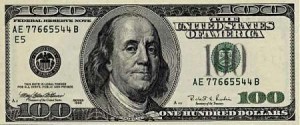
People always ask how much my book cost to produce. Some want to use the intel as they consider self- publishing, and some just like knowing things, I guess.
Most people scratch their heads when I answer that the cost depends on how many I sell. Here's where I tap my MBA to explain the importance of understanding that the total cost of your publishing effort includes fixed costs and variable costs.
Total cost = fixed cost + variable costs
Fixed costs. If you're an indie author who doesn't hire a ghostwriter, you've still got to pay other creative professionals to help you produce a quality product. You may not need a cover artist/photographer and layout designer if you're using a print-on-demand program, but please hire a copy editor.
 Be sure to capture any travel costs, meals you picked up for people you interviewed, research materials/subscriptions, and so on. Are you planning a book tour? What about promotional materials? Revamping your website so you can sell them online? Cha ching…these are fixed costs.
Be sure to capture any travel costs, meals you picked up for people you interviewed, research materials/subscriptions, and so on. Are you planning a book tour? What about promotional materials? Revamping your website so you can sell them online? Cha ching…these are fixed costs.
Allocate these over the number of books you sell. For example, say the fixed costs are $5k and you print 1000 books–hit each book with a cost of $5. Allocate that same $5k across 20,000 copies and you're down to $.25 per book.
Variable costs. In addition to the cost to print your books, you'll have to pay taxes and shipping on them, plus the costs to distribute them to readers and/or retailers. Order your quantity wisely. You'll be tempted to order a high quantity to get the lowest cost per book (unit cost), but if you don't sell what you print, this strategy will backfire.
For example, if you can get your unit cost down from $5 at 1,000 copies by ordering 2,000 books at $4 you'd better have a plan to sell every one of them. The cost per book is $16 if you only sell 500 books ($4 x 2000 copies ordered = $8000/500 copies sold =$16).
There is another variable cost that I don't have experience with, therefore no numbers to share, and that's distribution. If you use a book distributor you will pay a setup charge of somewhere around $500 plus a monthly storage charge plus a cut of your sales.
 Total cost. My fixed costs are upwards of $10,000 (photography, editing, design, travel, office supplies, promotional materials) and my book tour will run upwards of $10,000. If I print 1500 copies my total costs will run about $27,000, which means at a retail price of $25 I don't break even until I've sold 1080 copies.
Total cost. My fixed costs are upwards of $10,000 (photography, editing, design, travel, office supplies, promotional materials) and my book tour will run upwards of $10,000. If I print 1500 copies my total costs will run about $27,000, which means at a retail price of $25 I don't break even until I've sold 1080 copies.
You can play with the numbers and say I shouldn't charge the entire book tour to the book because I'll use it to market my ghostwriting services and to gin up paid speaking engagements. Fine, back the total cost down to $17,000 and at $25 retail, I break even at 680 sold copies.
Caveat: Nowhere in this post have I discussed the numbers related to wholesaling and consigning your book to retailers. At this point you need spreadsheet skills (or someone with them) to determine the total profitability of your book publishing venture. If you, like I, will pursue a blended strategy of selling books yourself at full retail and through retailers, your break even number will be higher than if you sold them yourself. Retailers who sell your book on consignment will take 40% off your retail price and pay AFTER they've sold it, while those (few) who buy it outright will take a 50% cut.
Is this any way to make a living?
Being an independent author is not a viable way to feed yourself unless you sell a ton of books, but if you use the book as a marketing vehicle, a book can be priceless. Compare a sunk pylon supporting a bridge to a book supporting your career. For many business professionals who want to speak at conferences and professional associations, a book credential is required before the organizers will consider your application. If your colleagues or competitors boast author credentials, your ante has been upped–get with it.

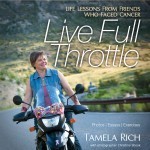


October 30, 2011
Book Tour with the International Motorcycle Show
I'll be following Progressive's International Motorcycle Show this season as I introduce audiences in twelve major markets to my book, Live Full Throttle: Life Lessons from Friends Who Faced Cancer. Here's the show schedule:
November 18-20 San Mateo, CA
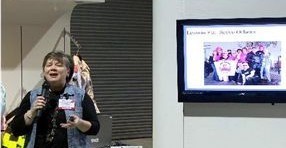
Tamela speaking at the 2010 International Motorcycle Show
December 2-4 Dallas, TX
December 9-11 Long Beach, CA
December 16-18 Seattle, WA
January 6-8 Novi, MI (near Detroit)
January 13-15 Washington, DC
January 20-22 New York, NY
January 27-29 Cleveland, OH
February 3-5 Minneapolis, MN
February 10-12 Chicago, IL
February 24-26 Charlotte, NC
March 14-17 Daytona Beach, FL
Speaking at bookstores and motorcycle club events
While I'm in each of these fair cities I'll be signing books and speaking about what I've learned about life after 25,000 miles across 32 states and 3 Canadian Provinces on my BMW motorcycle.
If you live near these cities I'd love to talk to your club. Perhaps you have a favorite book store you'd like to recommend I contact for a signing? Motorcycle dealerships often host authors with moto-themed books, so please let me know if your favorite dealer might be interested and I'll take it from there. Cancer support groups have been interested in talking to me about the book, so please let me know if I should contact any of them in your region.
If you're planning on attending one of the shows please look me up. I'm easy to find on Twitter: @TamelaRich and Facebook and GooglePlus.


October 25, 2011
Hardback or Softcover for your Self-Published Book?
 When you're publishing your own work, you're taking on all the departmental responsibilities of a publisher: editing, design, printing, financing, distributing and marketing. Unless you're publishing an e-book you'll have to choose a book binding.* Deciding between hardback and softcover lies at the intersection of finance and marketing.
When you're publishing your own work, you're taking on all the departmental responsibilities of a publisher: editing, design, printing, financing, distributing and marketing. Unless you're publishing an e-book you'll have to choose a book binding.* Deciding between hardback and softcover lies at the intersection of finance and marketing.
Readers are in transition, not just from print to electronic books, but also in our thinking about hardcovers and paperbacks. We're accustomed to seeing first editions in hardcover for a premium price, followed by softcovers at a discounted one. Some genres have been running first editions in softcover for some time now, but we have been conditioned to believe a hardcover will eventually come out in paperback at a lower price.
*Disclaimer: throughout this post I'm going to interchange hardback with hardcover as well as softcover with paperback.
Social conditioning and the hardcover
Intrinsic beliefs about hardcover books are best summarized by the equation Hardback=Quality. We've been conditioned to believe hardbacks are more valuable. They are keepsakes. A hardcover gift says the giver is a person of discriminating taste.
Then there's the matter of cost, which is easier to discuss rationally. A hardback is printed on cardboard, not paper. Cardboard and stitches have to cost a lot more than a glued-together paperback, right? Believe it or not, at a low quantity the hardcover may cost LESS to print than the softcover. That was the case with Live Full Throttle: Life Lessons From Friends Who Faced Cancer because it has front- and back-cover flaps (see below).
But the cost analysis shouldn't end with printing and binding. No matter the quality of the paper, the sturdiness of the cover, the earth-friendly inks that were used, the content is the same. That content originated in the author's brain, passed through an editorial process, was designed and illustrated, and then sent to the printer. I'll post on the intricacies of costing my book in November.
Market research
I had always intended to publish in paperback with flaps but caught a big case of second thoughts when I learned that a small run of books would cost less in hardcover than it would in paperback. I called my friend Karen, who owns The Bag Lady here in Charlotte, NC. Karen's long career in the book trade includes years as a book rep (selling to bookstores), a bookseller, a librarian and the proprietor of a book and gift store. I asked her to tell me about consumer behavior to hard/softcovers and her response fascinated me.
She told me that when people see a hardcover book priced at say $25, they may think that's a good price but will immediately wonder how much LESS they can get the paperback for if they wait a while. Because people are willing to WAIT for a paperback to come out, but won't tell the bookseller that's what they're waiting for, the bookseller can't tell them there is no forthcoming softcover (if that's the case) or WHEN that paperback is due on the shelves. By the time the paperback comes out the reader probably forgot about it and everyone walks away a loser–the author missed a sale and the reader missed a book.
Here's how I decided to go with paperback
[image error]Live Full Throttle is a combination memoir, photo essay and self-help book. The book is supposed to be written in, like a journal, because I included a set of exercises at the end of each chapter to help readers apply the information to their own lives. Keep this in mind as I walk you through my decision to go with a softcover.
Some people prefer softcovers for their portability.
Many readers say they don't want the pressure of preserving something so valuable as a hardcover.
A lot of self-help books are published exclusively paperback, which means buyers are accustomed to that form.
I called a couple of self-helpaholics who said they'd rather have a paperback for the journaling and portability.
Journaling and highlighting in a paperback is easier because the binding isn't as stiff as a hardback.
My book has 13 photos that span the gutter (the centerfold of the book). I was concerned about losing parts of the photos in a tightly-bound hardcover with 112 pages.Yes, photography books are usually produced in hardcovers, often cloth-bound with a dust jacket, but those books usually have more than 112 pages. While Christina Shook's photos are worth staring at (the pictures in this post are in the book), it's not a true coffee table book for the eyes; it's ultimately a book to be handled.
So many considerations for self-publishers, eh? Do your homework.
Go with flaps to re-enforce a softcover
I hate when the edges of a paperback bend and tear, as they inevitably do. Flaps greatly reduce this possibility. If you're printing a paperback, get a quote on cover flaps for protection.
I also like flaps for Live Full Throttle because they let me wrap the cover photo, taken in a Wyoming canyon, onto the back and not cover it up with a bunch of copy that I could instead place on the flaps. Flaps give the author more room for marketing messages.
I think that's enough for now. Next up is that financial discussion I promised. If you have other topics to suggest for this series, please ask in the comments section below.







